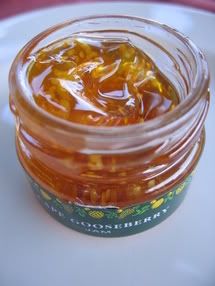Everything's Peachy
 When a Slow Food Berkeley peach-picking outing yielded four trays of gorgeous, perfectly ripe Elberta peaches, I was somewhat at a loss. Elbertas are hard to come by, since they are not suited to travelling long distances. But what they lack as a marketable, exportable asset, they make up for in sweet, rich, magnificent flavour. Being the Pie Queen, some of my delicious booty was reborn as mini peach pies. Which fed me, my housemates, colleagues at work, the panhandler on the way to work... until I couldn't bring myself to touch another pie (Well, ok - maybe just one more bite. Really.).
When a Slow Food Berkeley peach-picking outing yielded four trays of gorgeous, perfectly ripe Elberta peaches, I was somewhat at a loss. Elbertas are hard to come by, since they are not suited to travelling long distances. But what they lack as a marketable, exportable asset, they make up for in sweet, rich, magnificent flavour. Being the Pie Queen, some of my delicious booty was reborn as mini peach pies. Which fed me, my housemates, colleagues at work, the panhandler on the way to work... until I couldn't bring myself to touch another pie (Well, ok - maybe just one more bite. Really.).Over the winter, I used up a surplus of apples from my pie experiments by making apple butter. Now, fruit butters do not actually contain any dairy; you simply cook down ripe fruit until it forms a creamy, thick paste, perfect for spreading on some hot toast, swirling into some yoghurt, or perking up muffin batter. Some sugar is usually added, to take the edge off the tartness of the fruit, and perhaps some fruit juice if the fruit is not too moist, but other than that (and perhaps a pinch of cinnamon and nutmeg) it's pure fruity goodness. It's an old-school American tradition, now enjoying a revival at farmers' markets, but of course, there's nothing like the painstaking challenge of battling to make your own. I decided to take things up a notch from my fruit butter experiments last year; I tried my hand at canning my labours, too. Which delightfully coincided with the 22nd Sugar High Friday, a sweet-toothed monthly blogging event (this round hosted by Delicious Days), giving me additional motivation to blog about my sticky adventures.
Which is how this...

turned into this...
Deliciousness all round.
Peach Butter
Take as many perfectly ripe peaches as you like. Remember, these cook down, so two trays of peaches will make only four pints of butter. Blanch to remove their furry skins (one minute in boiling water, followed by one minute in ice water should loosen the skins perfectly). Chop into large chunks, and place in a heavy-bottomed pot. Add a pinch of salt, cover tightly, and leave over low heat. Within ten minutes the peaches should sweat out a lot of liquid, which simmers, cooking down the fruit. Stir occasionally until the peach pieces are soft, approximately thirty minutes.
Puree the peaches and their juice, either with a hand imulsion blender or a normal blender. Pour puree into a wide pot or pan with high sides; fruit butter tends to splutter a lot. You want only 1.5cm (3/4") level of puree in the pot, so you will have to cook your puree in several batches. The more puree there is in the pot, the longer it will take to cook down, and the less like fresh peaches your butter will taste.
Pour in some sugar (maybe half a cup if your fruit is already quite sweet), cover, and place over low heat. When it starts to simmer, stir to make sure evenly heated. When the whole pot of fruit puree is simmering lightly, you can remove or partially remove the lid to allow some of the liquid to evaporate. Cook, stirring frequently, until the puree has darkened to a rich, amber hue. Spoon a little onto a plate; it should hold its shape, and the edges should not be runny. You're going to be spreading - not pouring - this onto toast, remember!
 Spoon the butter into jars which you have already boiled for ten minutes, leaving 1/2cm (1/4") headspace. Run a little spatula around the sides of the jar, to free any air bubbles. Carefully wipe the rim of the jar with a clean cloth, and place the lid on top. Sticky, wet jar rims don't seal properly. Screw on a lid band, until you just meet with resistance. You don't want the lid on too tightly, or air in the butter won't be able to escape, causing a vacuum.
Spoon the butter into jars which you have already boiled for ten minutes, leaving 1/2cm (1/4") headspace. Run a little spatula around the sides of the jar, to free any air bubbles. Carefully wipe the rim of the jar with a clean cloth, and place the lid on top. Sticky, wet jar rims don't seal properly. Screw on a lid band, until you just meet with resistance. You don't want the lid on too tightly, or air in the butter won't be able to escape, causing a vacuum.
Now submerge these peach butter jars in boiling water for five to ten minutes, depending on the size of your jar. Carefully lift onto a heatproof surface (kitchen tongs wrapped with rubber bands help you to grip them securely). Flip over the jars so they're standing on their heads (this helps sterilize the lids), and leave them to cool, unmolested. Flip them over, right side up, and press on the top of the lid. If it moves up and down, it hasn't been sealed properly, and will need to be stored in the fridge. If the lid it taut, you have succeeded in canning peach butter. Congratulations! These jars of summer goodness should last on your shelf, out of direct light and fierce heat, for several months.

Categories: peach, pie, jam, canning




0 Comments:
Post a Comment
<< Home